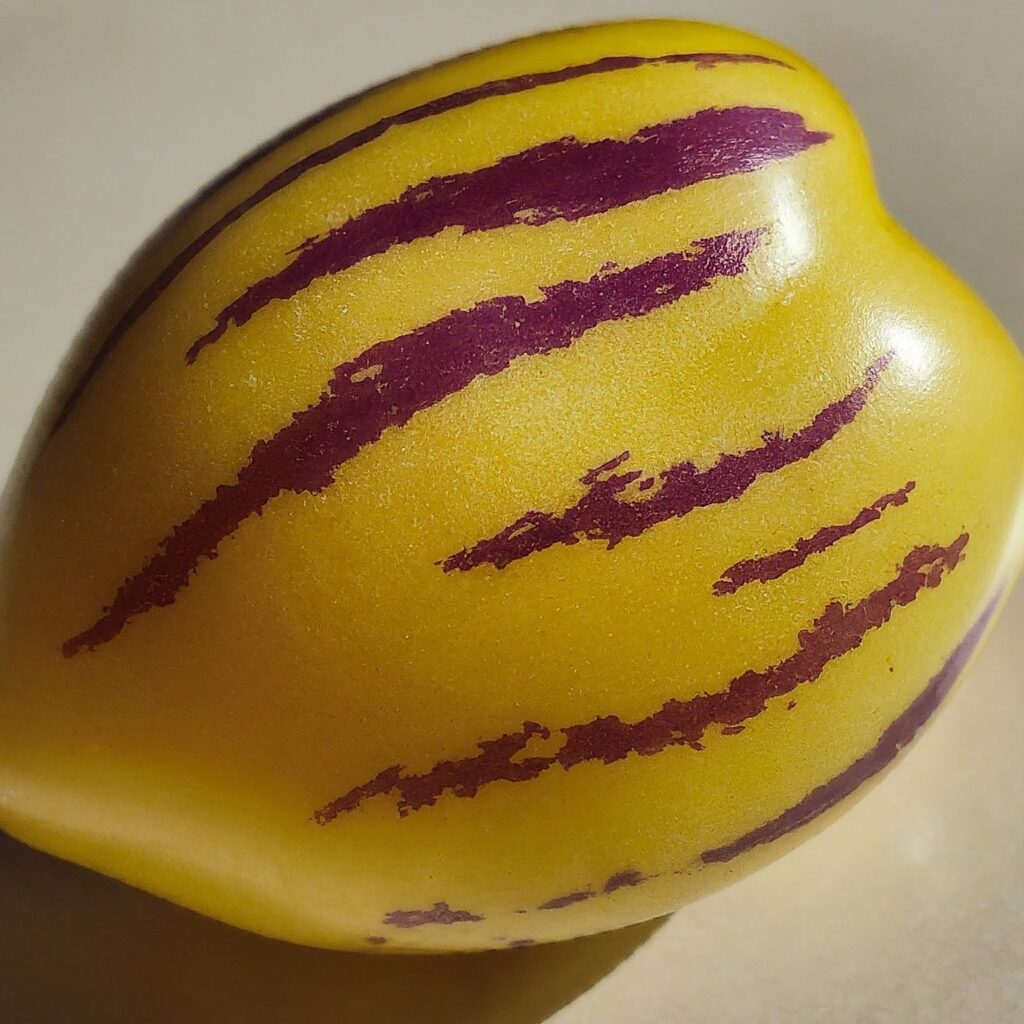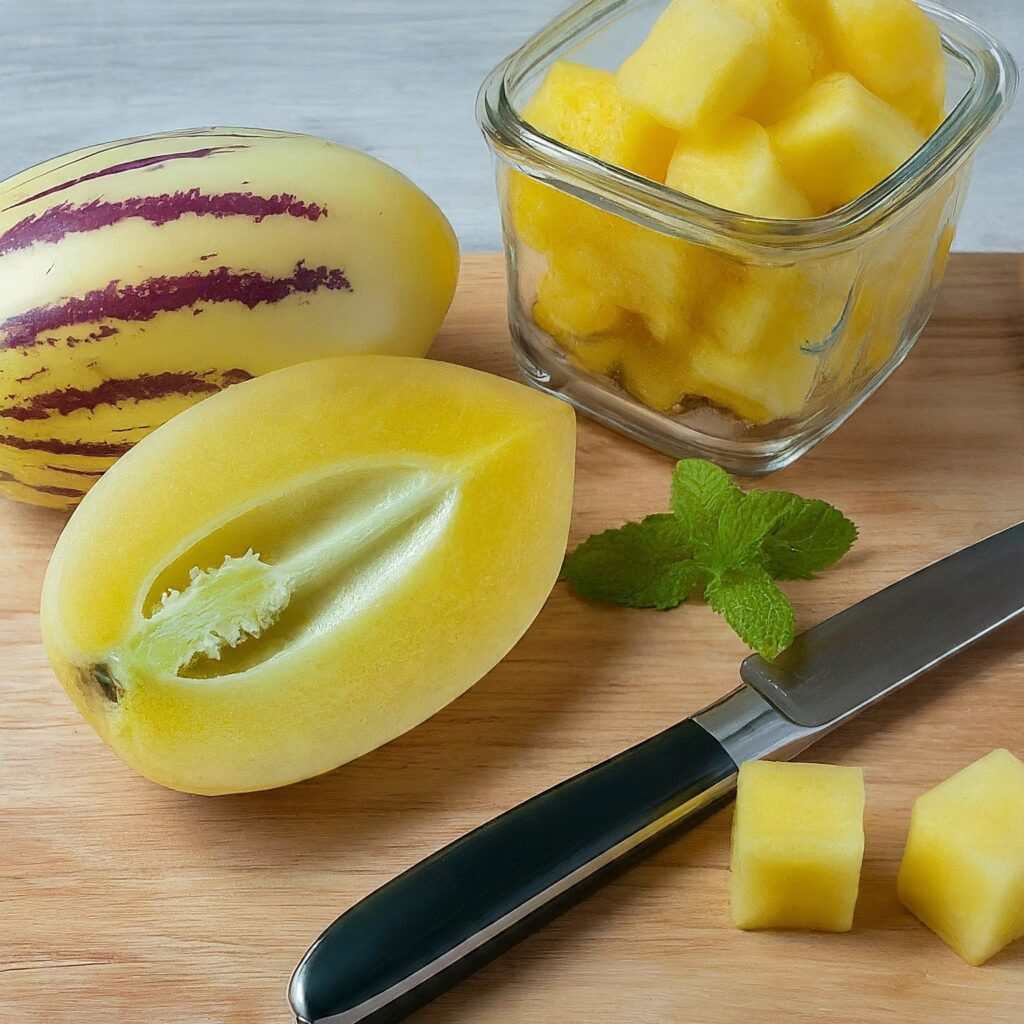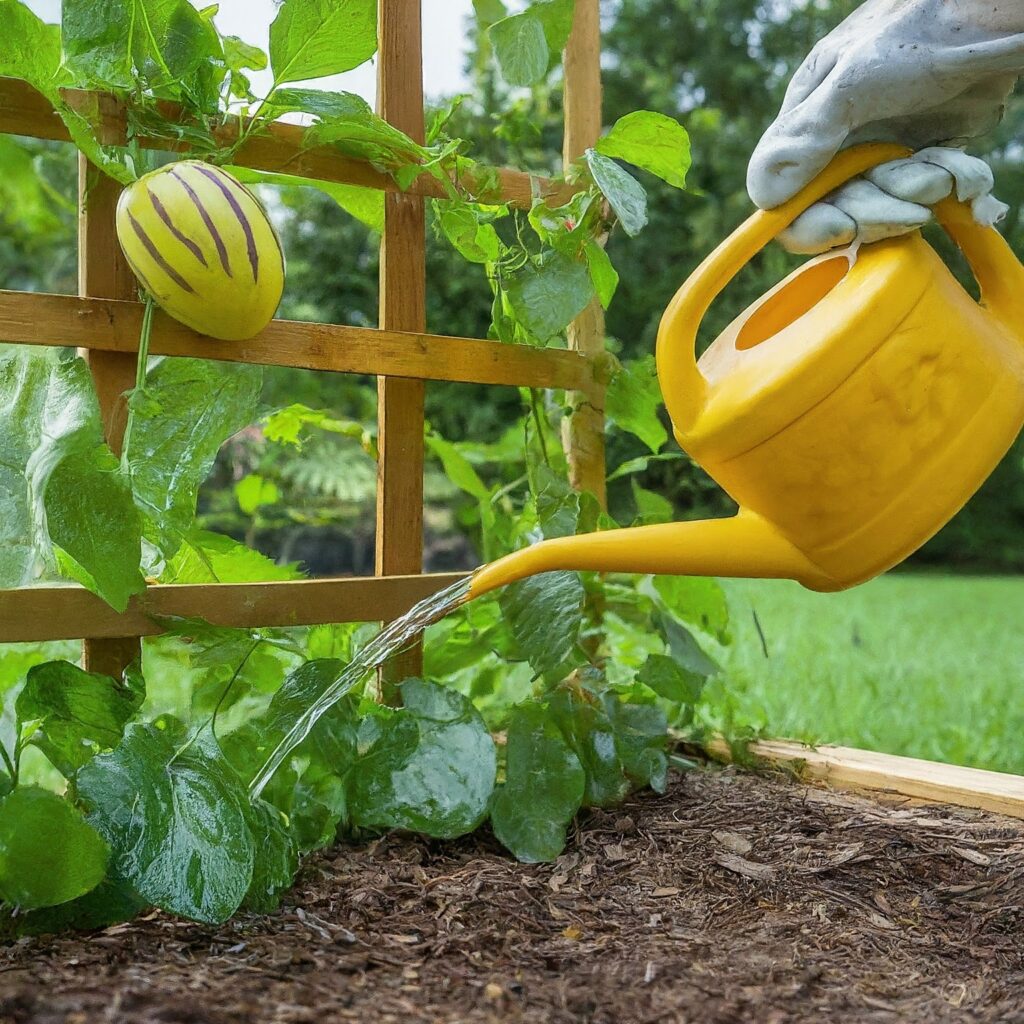Have you ever seen a fruit that looks like a misplaced egg in the melon patch? That’s the pepino melon.
The pepino melon, also known as Pepino dulce or sweet cucumber, is an intriguing and lesser-known fruit that has been gradually gaining popularity among health enthusiasts and culinary explorers alike.
Native to the Andean regions of South America, these small, oval-shaped fruits are celebrated not only for their unique, mildly sweet flavor, which is a delightful blend of melon and pear but also for their impressive nutritional profile.
As they make their way into more grocery stores and farmers’ markets, pepino melons are poised to become a staple in modern diets, offering a refreshing alternative to more familiar fruits.
In this article, we will explore the history, nutritional benefits, culinary uses, and tips for growing your own pepino melon. Whether you are a seasoned gardener or a curious foodie, there’s something extraordinary to discover about this exotic fruit.
Jump to a section:
- What is a Pepino Melon?
- The Origin of the Pepino Melon
- Health Benefits of Pepino Melons
- Where to Find Pepino Melon
- Selecting the Perfect Pepino Melon: Ripeness Signs
- How to Cut and Store Pepino Melon
- Growing Your Own Pepino Melon
- Pepino Melon Care and Maintenance
- Pest and Disease Control
- Harvest Time: Reaping the Rewards
- Savoring Your Bounty: From Garden to Plate
- Pepino Melon FAQ
What is a Pepino Melon?

The pepino melon (Solanum muricatum) might surprise you. It’s not actually a melon at all! Despite its name, this quirky fruit is a member of the nightshade family, alongside its cousins the tomato, potato, and eggplant.
This unexpected lineage might surprise you, but it hints at the unique qualities this fruit possesses. Pepino melon is actually a small, oval, or round fruit, roughly the size of a large kiwi or a small mango.
The smooth, inviting skin boasts a vibrant yellow base, often adorned with striking stripes of purple or lavender. It’s a visual feast even before you take a bite.
But the true magic unfolds when you crack it open.
Inside, nestled amongst the white or yellow seeds, awaits a creamy paradise. The flesh, available in shades of white, yellow, or even greenish, boasts a juicy texture and a flavor that’s a symphony of taste.
Pepino melon tastes like a harmonious blend of melon and honeydew, with a touch of citrus thrown in for good measure. A subtle tartness adds a refreshing complexity.
But the pepino melon’s charm extends beyond its captivating looks and delightful flavor.
It’s a fruit with a rich history, a hidden gem waiting to be discovered in your garden, and a potential source of health benefits that can’t be ignored.
So, the next time you encounter this misplaced egg in the produce aisle, remember – there’s more to the pepino melon than meets the eye. It’s an invitation to a world of flavor, history, and perhaps, a new star in your homegrown bounty.
The Origin of the Pepino Melon
The pepino melon’s history is as intriguing as its flavor.
Unlike many fruits with well-documented domestication stories, the pepino melon’s past remains shrouded in a bit of mystery.
While we can’t pinpoint the exact moment it transitioned from wild obscurity to a cultivated favorite, the clues point to a fascinating journey through the Andes Mountains of South America.
Here’s what we do know:
- A Mountain Majesty: Evidence suggests the pepino melon’s origin story unfolds in the temperate regions of the Andean mountain range, encompassing parts of modern-day Colombia, Peru, and Chile. These cool, mountainous environments provided the perfect climate for this unique fruit to thrive.
- Pre-Columbian Delight: Archaeological and historical findings suggest that the pepino melon was a cherished crop for indigenous peoples in the Andes long before European arrival. It likely played a role in their diet and cultural traditions.
- Domestication Enigma: The details of domestication remain a puzzle. Unlike many fruits where we can trace the selective breeding process, the pepino melon’s transition from wild to cultivated is less clear. However, its presence in pre-Columbian cultures suggests a long history of human interaction and appreciation for this unique fruit.
- A Global Expansion (of Sorts): While the pepino melon never achieved the widespread popularity of some other fruits, it did embark on a journey beyond the Andes. By the 18th century, it had found its way to Europe, and by the late 19th century, it was even being cultivated in California.
The pepino melon’s story is a testament to the fascinating relationship between humans and the natural world. It’s a tale of discovery, cultivation, and the enduring appeal of a delicious and unique fruit. While some details remain hidden in the mists of time, the pepino melon’s presence today is a reminder of its long and captivating journey.
Health Benefits of Pepino Melons
The pepino melon’s magic goes beyond its captivating flavor. It’s a potential treasure trove of health benefits, offering a delightful way to boost your well-being.
Here are some of the reasons to add this exotic fruit to your diet:
- Vitamin C: Pepino melons are brimming with Vitamin C, a crucial nutrient for a healthy immune system. Vitamin C acts like a superhero for your immune system, helping it ward off infections and keeping you feeling your best.
- Fiber: Dietary fiber is essential for a healthy digestive system, and pepino melons are a great source of it. Fiber keeps you feeling fuller for longer and can aid in regulating blood sugar levels.
- Low in Calories and Fat-Free: Looking for a guilt-free snack? Look no further than the pepino melon. These little fruits are low in calories and fat-free, making them a perfect choice for weight management or healthy snacking.
- Good for Heart Health: The presence of potassium in pepino melons might contribute to regulating blood pressure, potentially aiding in heart health.
- Antioxidant Power: Pepino melons contain antioxidants, which can help protect your cells from damage and may play a role in reducing the risk of chronic diseases.
Important Note: While these are potential benefits, it’s always wise to consult with a healthcare professional before making significant changes to your diet.
Where to Find Pepino Melon

Finding pepino melons in your local grocery store can be a challenge due to their limited commercial production. However, all is not lost!
Here are your options:
- Specialty Stores and Farmers Markets: Keep an eye out for pepino melons at farmers’ markets or specialty stores that carry unique produce.
- Grow Your Own! The best way to ensure a steady supply of these delicious fruits is to grow your own pepino melons. They’re surprisingly easy to cultivate, and the satisfaction of harvesting your homegrown bounty is unbeatable!
Selecting the Perfect Pepino Melon: Ripeness Signs
The key to unlocking the full flavor of the pepino melon lies in choosing a perfectly ripe specimen. An unripe pepino melon might be a bit bland and disappointing, while an overripe one can become mushy and lose its flavor.
So, how do you pick the perfect pepino melon?
Here’s how:
Visual Clues
First things first, visual clues are a great way to choose a perfect pepino melon.
As the fruit ripens, its skin transforms, becoming a canvas that reveals its readiness. Here’s what to look for:
- The Yellow Canvas: Initially, the pepino melon might have a greenish tinge to its skin. As it ripens, the green fades away, revealing a vibrant yellow base color. This yellow hue should be consistent and not patchy.
- Stripes of Distinction: Don’t forget the stripes! While the base color changes, so do the stripes. These beautiful markings, typically purple or lavender, should become deeper and more prominent as the fruit ripens.
- Beware of Blemishes: Just like any other fruit, blemishes can be a sign of damage or spoilage. Avoid pepino melons with soft spots, bruises, or wrinkles on the skin.
The Gentle Press Test
While visual cues are important, sight alone isn’t enough to pick the right pepino melon. To truly confirm ripeness, it is a good idea to engage another sense – touch.
Here’s where the gentle press test comes in:
- The Soft Touch: Apply gentle pressure to the blossom end of the pepino melon (the opposite end from the stem). If it gives slightly under your touch, that’s a good sign! A ripe pepino melon will have a slight give, but it shouldn’t feel mushy or overly soft.
- Too Firm, Try Again: If the pepino melon feels rock-hard and doesn’t give at all under gentle pressure, it’s likely not ripe yet. Leave it on the shelf for a few days and try the press test again.
- Too Soft, Move On: On the other hand, if the pepino melon feels mushy or gives way easily under pressure, it’s probably past its prime. It’s best to avoid these overripe fruits.
Remember, a perfectly ripe pepino melon awaits – all you need are your eyes and a gentle touch!
How to Cut and Store Pepino Melon

Once you’ve selected the perfect ripe pepino melon, it’s time to unlock its juicy goodness!
Here are our tips on how to cut and store these delightful fruits, ensuring you enjoy their flavor to the fullest.
Effortless Cutting Techniques
The beauty of pepino melons lies not just in their taste, but also in their ease of preparation. You don’t need any fancy equipment or culinary expertise to enjoy them.
Here are a couple of simple cutting methods:
- The Classic Slice: This is the most simple approach. Wash your pepino melon thoroughly and pat it dry. Using a sharp knife, cut the fruit in half lengthwise, just like you would a kiwi or a small avocado. This method provides you with two beautiful halves, perfect for scooping out the flesh with a spoon.
- Wedge It Up: For a more snack-friendly option, cut the pepino melon into wedges. Again, start by washing and drying the fruit. Place it on a cutting board and cut it in half lengthwise. Then, lay each half flat and slice it into wedges, similar to how you would cut a cantaloupe. This method creates bite-sized pieces that are perfect for sharing or enjoying on the go.
No Matter the Cut, Embrace the Seeds
Unlike some fruits where seeds are a nuisance, the pepino melon’s seeds are perfectly edible! They have a slight crunch and don’t detract from the flavor. Feel free to scoop them out with the flesh and enjoy them as part of the experience. You can also store the seeds to grow your very own pepino melons in your kitchen garden.
Storing Pepino Melon
Once your pepino melon is cut, it’s important to store it properly to maintain its freshness and flavor.
Here’s what you need to do:
- The best place to store cut pepino melon is in the refrigerator. The cool temperatures will help it stay fresh for several days.
- Exposure to air can dry out the flesh of the pepino melon. To prevent this, wrap the cut sides of the melon tightly in plastic wrap or store them in an airtight container.
- Properly stored pepino melon will stay fresh for 3-4 days in the refrigerator. This gives you ample time to enjoy its deliciousness.
Bonus Tip: Freeze for Later Enjoyment
While fresh is always best, you can also freeze pepino melon for later use. Simply cut the melon into cubes or wedges, spread them out on a baking sheet, and freeze for a few hours.
Once frozen, transfer the cubes or wedges to a freezer-safe container or bag. Frozen pepino melon can last for several months and can be used in smoothies, frozen yogurt creations, or even sorbet.
Growing Your Own Pepino Melon

Intrigued by the idea of growing your own pepino melons? You’re in for a treat!
These unique fruits are surprisingly easy to cultivate, offering the satisfaction of nurturing your own harvest and the chance to enjoy the fruits of your labor.
Here’s a comprehensive guide to take you from seed to slice on your pepino melon adventure:
Climate and Planting Requirements
Before diving headfirst into seed selection, it’s essential to understand if your climate is suitable for cultivating pepino melons. These little sunshine fruits thrive in warm environments with long growing seasons.
- Temperature: Pepino melons are frost-sensitive. This means they need warm temperatures to germinate, grow, and produce fruit. The ideal daytime temperatures for pepino melons range from 70°F to 85°F (21°C to 29°C). If you live in an area with cool summers or frequent frosts, it might be best to grow pepino melons indoors or in a greenhouse.
- Sunshine: Pepino melons love sunshine, so make sure to provide them with at least 6-8 hours of direct sunlight per day. This will ensure proper growth and fruit production.
Soil Preparation
Just like any plant, pepino melons need a happy home to flourish. :
- Drainage: Pepino melons don’t tolerate soggy soil. Well-draining soil is essential to prevent root rot and ensure healthy plant growth. If your existing soil is heavy clay, consider amending it with sand or perlite to improve drainage.
- Soil Fertility: Pepino melons appreciate fertile soil rich in organic matter. Amending your planting area with compost or aged manure a few weeks before planting will provide your pepino melons with the nutrients they need to thrive.
- Acidity Check: Pepino melons prefer slightly acidic soil with a pH level between 6.0 and 6.8. You can test your soil’s pH using a home testing kit and adjust it accordingly if needed.
Seeds or Seedlings?
You can either grow pepino melons from seeds or from seedlings you purchased from a nursery.
Here’s a breakdown of both options:
Seed Starting
If you enjoy the process of nurturing a plant from the very beginning, then starting your pepino melons from seeds is a rewarding option.
- Timing is Everything: Start your pepino melon seeds indoors 6-8 weeks before the last frost date in your area. This will give them time to grow strong and healthy before transplanting them outdoors.
- The Seeding Process: Fill pots with a well-draining seed starting mix. Sow the seeds about ¼ inch deep and space them about 2 inches apart. Keep the soil moist but not soggy and provide the seeds with plenty of warmth (around 70°F). Once the seedlings have a few sets of true leaves, harden them off for a week before transplanting them outdoors.
Here are some additional tips for successful seed starting:
- Use high-quality seeds from a reputable source.
- Bottom water your pots to ensure even moisture distribution.
- Provide the seedlings with plenty of light, such as using grow lights if needed.
Seedling Shortcut
If you’d prefer a quicker route, purchasing seedlings from a nursery is a great option.
Select healthy seedlings with vibrant green leaves, ensuring there are no signs of pests or diseases.
- Wait for the danger of frost to pass in your area.
- Choose a sunny spot with well-draining soil.
- Plant your seedlings 3-4 feet apart.
- Create holes wide and deep enough to accommodate the root ball.
- Gently place the seedling in the hole, ensuring the soil level stays the same as in the pot.
- Water the plants thoroughly after transplanting.
- Apply mulch and consider using a trellis for support as the seedlings grow.
Transplanting Time
If you planted pepino melon seeds indoors, you’ll need to transplant them outdoors under the right conditions.
Once the danger of frost has passed and your pepino melon seedlings have reached a height of about 6 inches with a few sets of true leaves, they’re ready to be transplanted outdoors.
Here are some key things to remember:
- Choosing the Right Spot: Select a location in your garden that receives at least 6-8 hours of direct sunlight per day. Ensure the soil is well-draining and amended as described earlier.
- Spacing It Out: Space your pepino melon plants 3-4 feet apart to allow them room to grow.
- Planting with Care: Carefully dig holes large enough to accommodate the root ball of your seedlings. Gently transplant the seedlings, ensuring the soil level around the stem remains the same as it was in the pot. Water the plants thoroughly after transplanting.
Pepino Melon Care and Maintenance

With your pepino melons nestled in their new home, here’s how to care for them throughout the growing season:
Watering
Consistent moisture is crucial for healthy pepino melon growth, especially during hot weather. Be sure to water your plants deeply every few days, allowing the soil to dry slightly between waterings. Avoid overwatering because it can cause root rot.
Weeding and Mulching
Regularly remove weeds that compete with your pepino melons for nutrients and water. Apply a layer of mulch around the base of the plants to retain moisture, suppress weeds, and regulate soil temperature.
Trellising (Optional)
Pepino melons are vining plants that can benefit from support. Consider using a trellis, fence, or other structure to encourage vertical growth. This improves air circulation around the plants, reduces the risk of disease, and makes harvesting easier.
If you choose not to trellis your plants, they will sprawl along the ground. While this is an option, it can make them more susceptible to pests and diseases.
Nutrient Boost
During the growing season, you may want to provide your pepino melons with a light feeding of a balanced fertilizer, such as a nitrogen fertilizer, every few weeks. This will give them the extra nutrients they need to produce a bountiful harvest.
Pollination
The good news is that pepino melons are self-pollinating, so you don’t need to worry about attracting bees or other pollinators. The flowers will take care of the pollination process themselves.
Pest and Disease Control
While pepino melons are generally considered low-maintenance plants, they can be susceptible to a few common pests and diseases.
Here’s how to keep your pepino melon patch healthy and thriving:
Common Pests
- Aphids: Keep an eye out for tiny sap-sucking aphids. These clusters often gather on the undersides of leaves, where they can stunt plant growth and even spread diseases. You can control aphids by spraying your plants with insecticidal soap or neem oil.
- Whiteflies: These small, flying insects also feed on plant sap and can weaken your pepino melons. You can manage them with insecticidal soap sprays or by introducing natural predators like ladybugs.
- Thrips: These slender insects damage leaves and flowers by feeding on plant tissue. Look for signs of silvery markings on the leaves. Insecticidal soap or neem oil sprays can help control thrips populations.
Disease Prevention
The best defense against disease is prevention.
- Proper Watering: Avoid overwatering, as it can lead to root rot. Instead, aim for consistent moisture without saturating the soil.
- Spacing and Airflow: Space your plants adequately to allow for good air circulation, which helps prevent fungal diseases.
- Crop Rotation: Rotate your crops each year to avoid a buildup of pathogens in the soil.
- Sanitation: Remove any diseased plant material from your garden immediately to prevent the spread of disease.
Severe Cases
If your pepino melons are severely infested with pests or diseases, it might be necessary to use a more potent solution. However, always prioritize organic pest control methods whenever possible.
Consult with your local gardening center or extension office for recommendations on specific pesticides or fungicides suitable for pepino melons.
Harvest Time: Reaping the Rewards
Patience is a virtue, and it will be rewarded when your pepino melons are finally ready for harvest!
Here’s how to know when it’s time to pick your homegrown treasures:
- The Color Change: Remember the vibrant yellow base color we discussed earlier? As the pepino melon ripens, the yellow areas will become even more pronounced. The contrast between the yellow and the purple stripes will also deepen.
- The Softening Whisper: Apply gentle pressure to the blossom end of the fruit. If it gives slightly under your touch, it’s perfectly ripe and ready to be enjoyed!
Savoring Your Bounty: From Garden to Plate

Now that you’ve nurtured your pepino melons from seed to harvest, it’s time to enjoy the fruits.
Here are some ideas to incorporate your homegrown pepino melons into your culinary adventures:
- Savor the Fresh Flavor: Slice your pepino melon in half, scoop out the seeds, and enjoy the refreshing flesh on its own. It’s a simple yet delightful way to experience the unique flavor of this exotic fruit.
- Get Creative in the Kitchen: Pepino melons are incredibly versatile. Dice them up for fruit salads, blend them into smoothies, or add them to yogurt parfaits. In Latin America, they’re even grilled as a side dish or used to make marinades for fish!
- Show Off Your Skills: Feeling adventurous? Use your pepino melons to create unique desserts, jams, or even cocktails. With a little creativity, you can turn your homegrown bounty into culinary masterpieces.
Growing your own pepino melons is a rewarding experience that allows you to connect with nature and enjoy the satisfaction of nurturing your own food. With a little TLC and the information in this guide, you can be well on your way to cultivating your own pepino melon patch and savoring the taste of this remarkable fruit.
So, why not give it a try? You might just discover a new favorite addition to your garden and your plate!
Pepino Melon FAQ
Can you eat pepino melon raw?
Absolutely! Simply wash them thoroughly, slice them in half, scoop out the seeds (which are also edible!), and enjoy the refreshing flesh.
What is the price of pepino fruit?
Pepino melons can be a bit on the expensive side due to their limited availability. Expect to pay anywhere from $2 to $5 per fruit, depending on your location and retailer.
Is pepino a fruit or vegetable?
Pepino melon is technically a fruit. It develops from the flower of the plant and contains seeds. However, in culinary terms, it can be used as both a fruit (in salads, smoothies, etc.) and a vegetable (grilled as a side dish).
Why is it called pepino?
The name “pepino” comes from the Spanish word “pepino” which means “cucumber.” This likely refers to the pepino melon’s elongated shape and green skin color in its unripe stage. However, the flavor is quite different from a cucumber!
Where do pepinos grow?
Pepino melons are native to the Andean mountain range in South America, encompassing parts of modern-day Colombia, Peru, and Chile. They thrive in cool, temperate climates.
What country is pepino melon from?
While the pepino melon’s exact origin story remains a bit of a mystery, archeological and historical evidence suggest it was a cherished crop for indigenous peoples in the Andes long before European arrival. So, it’s difficult to pinpoint a single “origin country.”
Where to plant pepino?
Pepino melons prefer warm climates with long growing seasons. If you live in an area with very cool summers or frequent frosts, it might be best to grow them indoors or in a greenhouse. Make sure to plant them in a sunny spot in your garden with well-draining soil.



